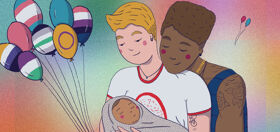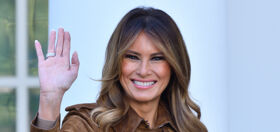
If there are two things gays like to be at the forefront of it’s trends and liquor. Combine the two and you have the gay obsession with what cocktail is in and which isn’t. Don’t believe us? We dare you to go into a gay bar in any major metropolitan area on a busy night and loudly order a Cosmo. (We apologize in advance if you really like Cosmo’s and in fact, the best kind of drink is the one that’s best for you.) Still, one of the best ways to take the temperature of the gay community is to see what they’re drinking, as our look into the recent past reveals.
 B.C.: Before Cosmo (pre-1997)
B.C.: Before Cosmo (pre-1997)
Oh sure, gays were getting drunk long before the Cosmo came to town, but it’s remembered now as a shadowy world of light beers, wine coolers, Cape Cods, Long Island Iced Teas and other seashore-related libations. People drank and certain drinks were more popular than others, but the idea that everyone just had to be drinking the same thing was unheard of. Early gays did not yet know the unifying power of a single cocktail and so, like hunter-gatherers, each found his own respective drink, rarely holding much allegiance one way or another, unaware that just beyond the horizon a new sunset beckoned.
 The Cosmo (1997-2001)
The Cosmo (1997-2001)
The Cosmopolitan wasn’t just a drink, it was a way of life. Though it had been around since the 1970’s, most likely created by gay men in Provincetown, it wasn’t until the early 90s when Odeon bartender Toby Cecchini replaced the drink’s original call for Rose’s lime syrup with fresh-squeezed lime juice and added Cointreau to balance the flavors that the drink really began to take off.
It was the 1997 opening of New York City’s G Lounge, however, that transformed the Cosmo from being just a labor-intensive sweet martini into the cultural Sex in the City/Ohmygod-I-am-so-embarrassed-my-mother-is-drinking-it icon that it’s now become. G Lounge was the first gay bar in New York to embrace style and design. Gay bars of yesteryear had dark plywood walls and windowless facades. G Lounge aimed for slick and open, it’s glass windows letting any passerby on 19th Street to look in on the action. At the center of it was The Cosmo, whose very name fit in with the decor. Mania for the drink continued and soon G was serving frozen slushy versions of the drink while the rest of the city’s gay bars played catch-up; embracing a style and sweetness that said in the boom time, post-AIDS crisis that fun was back.
Sure, it was Carrie Bradshaw and company who popularized the drink in mainstream America, but the ubiquity of it wasn’t overhyped on the show: Everyone you knew drank cosmos, all the time. Every time the Cosmo trend looked to be flagging, a new group would discover it or rediscover it and the whole process started over again, like the tech bubble, but with alcohol. Once it became the queer drink for the straight guy, the Cosmo’s days in gay bars was doomed and ever since, people have searched for “the next Cosmo.”
How about we take this to the next level?
Our newsletter is like a refreshing cocktail (or mocktail) of LGBTQ+ entertainment and pop culture, served up with a side of eye-candy.
 The Mojito (2000-2003)
The Mojito (2000-2003)
Simply put, no drink could ever hope to be the true heir of the mighty Cosmo, but the mojito came pretty damn close. Our guess is that it won out simply because of all the sweet-flavored challengers to the throne. The mojito, which requires approximately seven days to make, was the only thing more complicated to make than the Cosmo. It also had the added benefits of being a Latin drink that didn’t have a pineapple in it and was served in something besides a martini glass. Which is why, by 2002, even James Bond was drinking it in Die Another Day. You would think that after 9/11, drinks would go back to simplicity, but now cocktails were seen less and less as things designed to get you blasted and more like small works of art. Bar owners, more than willing to find an excuse to jack-up the prices, were happy to oblige.
 Sake/ Cucumber-Infused/ Anything with a Complicated Garnish (2004)
Sake/ Cucumber-Infused/ Anything with a Complicated Garnish (2004)
2004 marked the high point of cocktail baroque. As the country went to war and our rights went down the can, at the very least we could have a fancy cocktail. Bartenders started to look more like apothecaries with infusions, tinctures, washes and gold-dust rims on hand to whip up increasingly nonsensical drinks. With so many mutant drinks running around, it wasn’t long before there was a call for new found order and simplicity.
 Pomegranate Martini (2005)
Pomegranate Martini (2005)
For a brief shining moment, order and harmony was restored to the world of the gay cocktail. As the world fell apart and Bush began a second term, the pomegranate martini was the drink of choice. Even Oprah named it as her favorite drink, though in reality, despite the dubious claims of health benefits, the pomegranate martini’s popularity was solely based on the fact that it reminded people of drinking a Cosmo. After the better part of a decade being spent in pursuit of the “new Cosmo”, the time had finally come to start looking for something else.
 Rosé (Summer 2006)
Rosé (Summer 2006)
Things had become so bad that for a moment, the cocktail of choice wasn’t even a cocktail at all, it was a wine. Rosé wine, that bastard child that’s neither red nor white, served in paper cups over ice, became, according the NYTimes, “the new Cosmo”, with its associations of St. Tropez and the Carribean. People enjoyed it because it didn’t give them a hangover. If the Cosmo exemplified the showiness of gay style in the 90s, rosé captured the studied casualness and low-rent virtues of the new hipsterati.
 Vodka & Tonic (2006-2007)
Vodka & Tonic (2006-2007)
Eventually, everyone seemed to catch on that alcohol on its own has a pretty high-caloric intake, but mix it with sugar and fruit juice and you’re downing your gym routine every night at the bar. A vodka tonic with lime exemplifies the new simplicity ethos, but at the same time, seems a bit like overkill. A vodka tonic will get you drunk, but it’s also drab and boring. Put it this way, when you drink a vodka tonic, you’re only a glass full of fizzy water away from being a lonely Siberian doing shots on the steppes.
 The Return of the Classic Cocktail (2008-present)
The Return of the Classic Cocktail (2008-present)
Manhattans, Sazeracs, Old-Fashioneds and Brown Derbys; the drinks your great-grandfather drank, are being rediscovered by a new generation. Where the Cosmo promised a night out on the town with the girls, today’s popular drinks evoke dim-lounges filled with well-dressed men eying each other in the night. Perhaps it’s a sign of progress that the gay bars of the 30s, 40s and 50s, which thrived on danger and shame, are viewed by the modern gay community as places of mystery and intrigue. Maybe it’s that even though we’re emulating the drinking habits of old, we’re no longer hiding in the dark. It could just be that the classics taste so good. My drink of choice at the moment is a French 75, a combination of gin, lemon, simple syrup and champagne, named during World War I for the artillery shell which gave a similar kick. The upshot of the “classic cocktail” meme is that people are now ordering based on their own personal preference, meaning that perhaps the days of the gay solidarity cocktail are at long last, numbered.




















Pragmatist
I just order a Pellegrino or Perrier nearly every time I go to a bar (gay or straight). Getting drunk is no longer the thrill it was back in college. Plus, it leads to bad breath, premature aging, and potbelly. (Also, who in the greater LA area can realistically afford to pay taxis for roundtrips?)
Qjersey
What no mention of “the Abbey” and the Appletini served in huge martini glasses with a slice of green apple?
tsk tsk
and what about the 70’s classic the Harvey Wallbanger and it’s many variations:
Harvey Wallbanger up against the wall?
Harvey Wallbanger up againt the wall Mexican Style?
Yes we know, our dear editor is a youngin, and history only goes back 10 years for 20 somethings.
Signed a 40 something.
80's gay bar owner
How could you have missed mentioning the gayest cocktail (at least name-wise) of all time? The sloe screw! (sloe gin and orange juice)
Joe Moag
Japhy: Great piece! I wrote a piece for another website about the fact that I am a beer drinker, and the piece was a debate between myself and another gay man who drinks vodka. You wouldn’t believe the comments I got on this…
Funny!
Anarchos
@Qjersey: Yeah I thought for sure the appletini would get a mention here. Oh well. I think cocktail fads (like most fads) are kind of dumb, and people should just drink whatever the fuck they want, and be less concerned with how they look drinking it. The classic cocktail craze will slow, and people will move on to something else.
THorton
You’re all over-looking the most popular gay trend of the past three-four years at least (one that does not appear to be going away judging from a casual survey of any gay holiday party) – The sugar-free red bull and (insert flavor here) Absolut.
I mean, if you line up all the flavors of absolut together you basically have the gay-pride flag in glass-bottle form. Add in sugar-free redbull and you’ve got a calorie-concious tasty cocktail, preferably in a tall glass.
I’m just sayin’.
And no, I don’t work for Absolut or Red Bull.
Donnie
I was asked this very question this weekend so its wonderful to actually find a great piece about the very subject. Yes, it is foolish, and lightweight story, but what the hell, you want gay bashings and beatings, head over to towleroad. My pick for today would be the classic Vermouth Cassis…very lesbian.
ChicagoJimmy
Great picture, because Mount Gay Rum is the best! Mixed properly with Coke and you’ll think you’re drinking a classic Vanilla Coke. For those of you watching your calories, you can always choose diet.
Two Ladies in Waiting
Great article — though I imagine that merely publishing it marks today as the day that classic cocktails are passe. Alas, I will stick to my Manhattan anyway.
Michael
That’s funny, Donnie, because it’s true: Towleroad used to be a tad lighter, right? It could use some levity now and then.
flightoftheseabird
@THorton: You have to be somewhat careful with the Vodka/Red Bull drinks. Red Bull being a stimulant and Vodka being a depressant can have some serious adverse consequences (death and heart attack are first to come to mind). More than alcohol consumption in general, drink in extreme moderation.
Alex
My drink is definitely an Old Fashioned, which (I hate to admit) I started drinking after seeing Jon Hamm drink them in Mad Men, which I guess fits the trend.
I once read somewhere that at some point all the gay bars stopped serving screwdrivers because of Anita’s sponsorship of Florida OJ. Orange juice was replaced with apple juice and the drink was called an Anita Bryant. This, however, was all before my time, and I can’t remember where I read it. Perhaps one of my esteemed gay elders can confirm or deny this story.
Jay
Though the rose-fuckin-a trend cannot be denied, I believe there are still a number of sad faggots out there still ordering cosmos and mojitos by the dozen, and I assert the gay solidarity cocktail remains the Ketel Soda.
http://www.thesword.com/index.php/cultureschlock/1740-in-honor-of-repeal-day-the-5-gayest-cocktails-of-all-time.html
Debby
It is so hard to find a mojito that is made correctly. I have been to one restaurant that I loved the mojito that they served.
I think there are some popular drinks that have been left off the list.